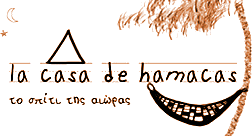The Greek Hammock Brand La Casa De Hamacas
Date Published: 03/05/2012
History of Hammocks
The hammock has a great history that spans over 4,000 years. The European navigators and explorers were delighted by the way of using this "bed" due to the ease of use and comfort. After many years the Europeans in their effort to replicate the traditional hammock, began to produce bad copies and this is the time that the need for real, traditional hammocks returns.
The historical background of the hammock.
The word “Hamaca” most likely comes from the name of the tree «Hamack», of which the first fibres were used for the construction of the hammock. The first hammocks are made from this material by the Mayans in Central America at 2,000 BC. However, this material was replaced by the soft and more resistant material; cotton, but the designs and the production method of the hammock remained the same.
The hammock was discovered by the Spanish conquerors during their invasion in Central America, and was originally used as beds for the members of the missions in the boats which were returning from the so-called "New World".
Soon the senior officers 'copied' the idea, and the need for economy in space parallaxed the traditional hammock to something resembling a hammock, however it had lost all its characteristics. This bad hammock copy remains in peoples mind even now and has resulted in a poor understanding of the hammock, and that all hammocks are the same.! (Big mistake)
In 1514, after nearly 30 years of understanding the broader culture of Central America and the Caribbean, began importing in Europe new words, products and cultures, which were never again been heard in Europe. Words such as 'exotica', 'canoe', 'smoking of Tabacco', 'hamacas', began creating Trends. However, the Hamaca, first appeared in Europe after the first voyage of Columbus in 1492.
"Indigenous people are sleeping in beds that are called «Hamaca» - hammock – and look like a piece of fabric that has 2 open ends firmly tied .... like a net made of fibers almost 3 to 4 meters long. At the edge all these endings made of rope, create a knot, a knit one, from where it can be hung. They are good and clean beds, and since the weather is warm, you do not need any other cover but the hammock.... which is also easy to transportation and placement.
(Gonzalo Fernandes De Oviedo y Valdes, Seville, 1535)
Another interpretation that refers to the use and where the word «Hamacas» comes from, says that the word comes from the HaitianTribe Taino, dialect Arawakan, which means "net" and as a technique was used to produce nets for fishing.
The reason that hammocks became so popular in the Central American countries was because of their characteristics, they provided safeness from insects, snakes, and even infectious diseases. Placing this peculiar bed, hovering above the ground, tied to two trees, natives were better protected from animal attacks, snakes and insect bites, creating an unbreakable space, that provided security ideal for rest and sleep.
La Casa De Hamacas
Find us on Facebook
Follow us on Twitter
tel. 0034 6977 501318







